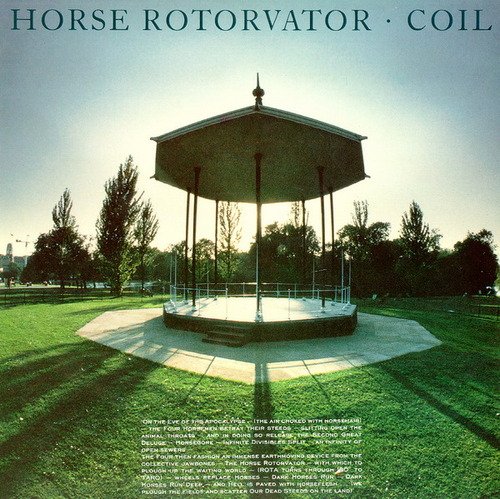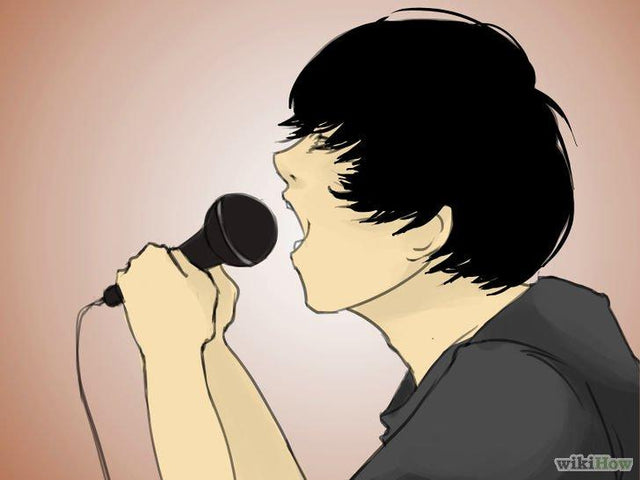Industrial music is melody fashioned from noise. It’s the ratio of the former to the latter that ultimately determines what that sounds like. In the U.K. in the 1970s, industrial was born of provocative performance artists like Throbbing Gristle, who combined controversial images with music that leaned far from pop structures, instead employing drones, improvisation, spoken word and harsh noise. Over time that sensibility evolved into something still harrowing, still darkly haunting, yet more melodic and structured. In less than two decades, industrial went from exploitation film reels in warehouses to prime time on MTV.
The mention of industrial more than 40 years after its genesis likely brings to mind one of two ideas: the free-form noise art of its earliest years, or the goth-club pulse of Ministry and Nine Inch Nails. But it’s everything that’s happened in between that has made industrial an even more interesting and fertile genre for artistic exploration. Here are 10 of the best albums to come from its fascinating evolution.

Throbbing Gristle 20 Jazz Funk Greats
Throbbing Gristle invented industrial music. In fact, they coined the term — Industrial Records was their label, and the phrase “industrial music for industrial people” became their slogan, starting with 1977’s The Second Annual Report. Though in the beginning, what “industrial” meant wasn’t as well-defined. Forming as COUM Transmissions in the U.K. in the mid-’70s, Genesis P. Orridge, Chris Carter, Cosey Fanni Tutti and Peter “Sleazy” Christopherson eventually adopted the name Throbbing Gristle, performing confrontational live sets featuring pornographic or violent images while they created cacophonous music, often with spoken word accompaniment, ultimately leading to masterpieces of horror like 1978’s “Hamburger Lady.”
Their crowning achievement was 1979’s 20 Jazz Funk Greats, an album that represents Throbbing Gristle at their most musical — though that’s a relative term. The album cover depicts the band looking cheery at Beachy Head, a notorious suicide spot in Britain, a sort of bait-and-switch move that served to provoke unsuspecting listeners thumbing through record store bins. Yet while this album is harsh, it’s also rhythmic and often accessible in parts, offering their interpretations of exotica, dub and minimal synth-punk in the vein of Suicide. It also contains “Hot on the Heels of Love,” their most straightforward disco number, borrowing liberally from Giorgio Moroder’s bag of tricks. There are moments of relative calm, even hooks, but every track feels precarious and uneasy, each moment melody existing to create a false sense of comfort — only for the band to snatch it away one moment later.

Killing Joke: Killing Joke
London post-punk group Killing Joke arguably didn’t make the full transformation into industrial metal until the early ’90s, when they released Extremities, Dirt and Various Repressed Emotions. Yet the foundation of those relentless, grinding anthems lies in the harsh punk rock stomp of their self-titled debut. The album — while entirely made with a traditional guitar, bass, drums lineup — is awash in cold, metallic sounds and corrosive effects. The synth warble that introduces “Requiem” is something like a primitive template for the processed, sequenced sounds Ministry and Nine Inch Nails would later adopt, while Jaz Coleman’s disorienting and distorted vocal effect in “Wardance” lends the song the kind of bizarre terror that can be tied back to earlier industrial. As industrial goes, Killing Joke’s debut is more crucial for laying the foundation than seeing the sound fully realized, but it’s an essential missing link.

Nurse With Wound: Homotopy to Marie
Stephen Stapleton isn’t just an important figure in experimental music, but a highly prolific one. His catalog boasts more than 60 studio albums, as well as a long list of collaborations with artists within industrial music (Current 93), prototypes of the genre (Faust) and those entirely outside it (Stereolab). His masterpiece, Homotopy to Marie, came relatively early in his career, and is a 50-minute sound collage that pairs the performance art aesthetic of Throbbing Gristle’s avant-gardism with an even more absurd, surrealist sensibility. Scant few moments on Homotopy to Marie resemble actual melodies, and those moments often come after the listener’s led through horrifying labyrinths of clanging cymbals, found dialogue, creaking doors, barking dogs and various other sounds that are most unnerving when the lights are off and everything else is eerily quiet. That so much of the album is empty space only serves to make the noises on Stapleton’s tape loops that much more terrifying. While later industrial artists would make rhythmic patterns of such harsh noises and effects, Stapleton found his artistry in a twisted symphony of chaos.

Cabaret Voltaire: 2x45
Sheffield’s Cabaret Voltaire began much like Throbbing Gristle did, through performance art displays coupled with tape-loop experiments. Yet the band — named for a Zurich club at the center of the Dadaist movement in the early 20th century — evolved through various phases of their career, making an early impression with synth-punk singles like “Nag Nag Nag” before incorporating darker, harsher sounds that more closely resemble the intense approach of what we now know as “industrial.” Their fourth album 2x45, released after their harsher early records and the more dancefloor-friendly material of their electronic body music (EBM) period, is Cabaret Voltaire’s most wildly creative release, blending dance punk, no wave and the electronics-heavy militarism of early industrial. It’s one of their most fun records, driven by the grooves of highlights such as leadoff track “Breathe Deep” and “Protection,” but it’s also among their most strange and sinister recordings. The twisted vocals and chaotic density of “War of Nerves” comes across a bit like a funky Godflesh. It’s among the band’s more accessible albums, despite the sometimes harsh elements and, tellingly, was the first to land on the U.K. album chart.

Einstürzende Neubauten: Halber Mensch
Einstürzende Neubauten’s name translates to “collapsing new buildings,” which essentially summarizes the German band’s ethos. They took the idea of industrial to its literal extreme, crafting sounds from pieces of metal and hardware, the harsh noises they made often more aligned with musique concrete than actual songwriting. Halber Mensch (translation: half man) represented a breakthrough for the band in that their compositions became much more musical, more human even, if still quite terrifying. The album’s title track is a choral piece, for instance, but it’s the stuff of nightmares — a septet of voices chanting as if engaged in a cult ritual. “Yü-Gung,” however abrasive it might be, is still driven by a steady 4/4 beat and Blixa Bargeld’s rhythmic vocal barks. There’s even a peculiar beauty to the highlights “Seele Brennt” and “Sensucht.” In the years to come the group would embrace more conventional melodies, their videos even appearing once or twice on MTV’s 120 Minutes, but no album so fluidly merged the cacophony of their scrap-metal instrumentation with honest-to-goodness songs quite like this one.

Foetus: Nail
J.G. Thirlwell has amassed nearly as many aliases as he has recordings over the years — You’ve Got Foetus On Your Breath, Scraping Foetus Off the Wheel, Steroid Maximus and Clint Ruin, to name a few. But the evolution of his many monikers speaks to the constant creativity from the mind of the Australian musical mad scientist. Nail, his fourth studio album as Foetus (Scraping Foetus Off the Wheel, for those keeping track), is at once his most accessible and most boundlessly creative set of music. A merger of industrial’s clanging, metallic percussive sounds with blues, jazz, post-punk and even show tunes, the album at times feels like Raymond Scott’s cartoon scores performed by evil robots.
Thirlwell’s points of reference are numerous and diverse, borrowing from Shakespeare on the punk-blues stomp “Throne of Agony,” while “Enter the Exterminator” incorporates elements of Grieg’s “In the Hall of the Mountain King” and “DI-1-9026” nods to Timothy Leary. By the time the album reaches final track “Anything (Viva!)”, Thirlwell yelps, “I can do any goddamn thing I want!” Indeed.

Coil: Horse Rotorvator
The cover art of Coil’s Horse Rotorvator, a simple yet eerie image of an empty gazebo with its shadows spanning across an empty field, is imprinted with a short narrative about an “immense earthmoving device” fashioned from the jawbones of the steeds of the Four Horsemen of the Apocalypse. That’s a good indication of the kinds of ominous horrors that await the listener on the album. Where an artist like Nurse With Wound is terrifying because of the utter incomprehensibility of what’s going on, Coil creates a similar kind of horror from something much more accessible, even pretty. John Balance, Stephen Thrower and former Throbbing Gristle member Peter Christopherson find beauty in depravity and vice versa, showcasing a hauntingly tender side on the ballad “Ostia (The Death of Pasolini),” a proto-neofolk dirge about the brutal murder of film director Pier Paolo Pasolini in 1975. There’s also the punishing martial stomp of EBM on “Penetralia” and blood-curdling atonality in “Blood From the Air.” A familiar voice to new wave listeners also appears on the death-blues standout “Slur,” namely Soft Cell’s Marc Almond, credited under the name Raoul Revere. Just two years prior, in fact, Coil had done their own cover of “Tainted Love,” which Soft Cell made famous, with Almond appearing in the video symbolizing the Angel of Death.

Ministry: The Land of Rape and Honey
Ministry’s early years were spent throwing just about everything at the wall and seeing what stuck (synth-pop, new romantic, goth rock), and the past couple decades have seen them settle into political, punchline-heavy industrial metal. But in the mid-’80s, Al Jourgensen and company hit their stride, essentially creating the template for industrial rock. Where industrial historically has had one foot in the art space and the other on the dancefloor, Ministry’s long preferred the latter, their sample-heavy sounds creating a collision of electronic beats and heavy metal guitars.
The Land of Rape and Honey is by no means their most streamlined album, but it’s easily their best, a creative explosion of darkly atmospheric menace and sheer volume. With “Stigmata,” they crafted a club anthem to rival their earlier, kitschier single “Every Day Is Halloween,” whereas “The Missing” found them pushing father into metal aesthetics and “Golden Dawn” evoked an apocalyptic, cinematic atmosphere that conjures images of crumbling buildings and plumes of smoke. Though Ministry are far from the most serious band in industrial’s history, they were the first to master it as a large-scale, mainstream-friendly production.

Godflesh: Streetcleaner
Justin Broadrick was only 19 years old when he made his landmark industrial-metal debut with Godflesh, 1989’s Streetcleaner. That’s a remarkable fact considering it doesn’t sound like the work of barely an adult — it’s the kind of sound you’d expect to hear coming from malevolent, immortal beings who live beneath the surface of the earth. Where the roots of industrial metal came primarily from artists who evolved from industrial’s early, post-punk roots — such as Killing Joke or Ministry — Godflesh’s personnel were already somewhat established more in metal itself, Broadrick having briefly played in Napalm Death before slowing the tempo and enlisting a drum machine. Streetcleaner, as a result, isn’t anywhere in the vicinity of a dance album — it’s a harsh series of pitch-shifted primal screams, grinding guitar riffs and Roland bass thuds. It’s the sound of a particularly sadistic dystopia.

Nine Inch Nails: The Downward Spiral
For the vast majority of pioneering industrial acts, mainstream acceptance wasn’t much of a factor, and in the case of Throbbing Gristle, crossover success was an idea that went entirely against their provocative sensibilities. Yet for Trent Reznor, an artist who actually collaborated with members of Throbbing Gristle, pop and industrial weren’t contradictions. Rolling Stone described Nine Inch Nails’ debut Pretty Hate Machine as “the first singer/songwriter industrial album,” and with its 1994 follow-up, The Downward Spiral, Reznor used that early blueprint to build a cohesive, conceptual art-rock album using the tools of industrial to craft its widescreen sound.
Upon its release, The Downward Spiral was an unprecedented breakthrough for industrial music, showcasing both the manic extremes of sample-based industrial metal (“March of the Pigs”) as well as its most introspective and devastating balladry (“Hurt”). At times, the album even resembles a robotic entity lumbering through showers of sparks, as on the ferocious “Reptile.” It’s a masterpiece of production, one that made the idea of industrial music universally recognized, thanks in no small part to the runaway hit sex jam, “Closer.” The fact that Maxwell covered the track on MTV’s Unplugged just a couple years later marked a somewhat surreal moment where the line between a once noise-ridden underground culture and Top 40 had finally blurred.
Jeff Terich is a freelance writer whose work has appeared in Bandcamp Daily, Stereogum, FLOOD and various other outlets. He also runs the indie music website Treble, plays guitar and occasionally DJs. He lives in San Diego with his wife and two cats.
Related Articles
Join the Club!
Join Now, Starting at $44
Exclusive 15% Off for Teachers, Students, Military members, Healthcare professionals & First Responders - Get Verified!







